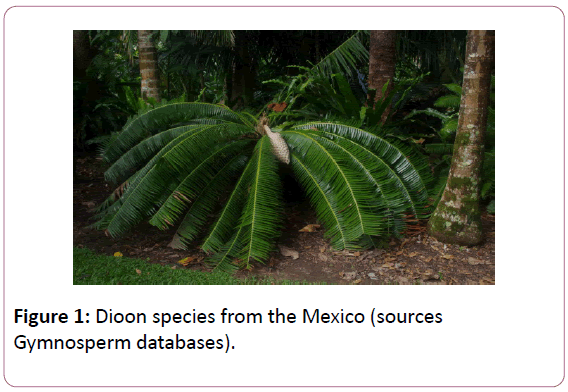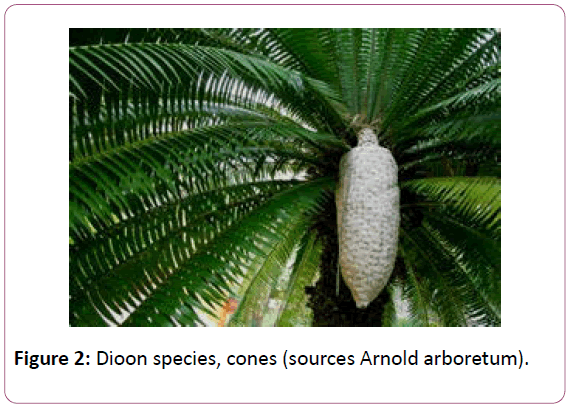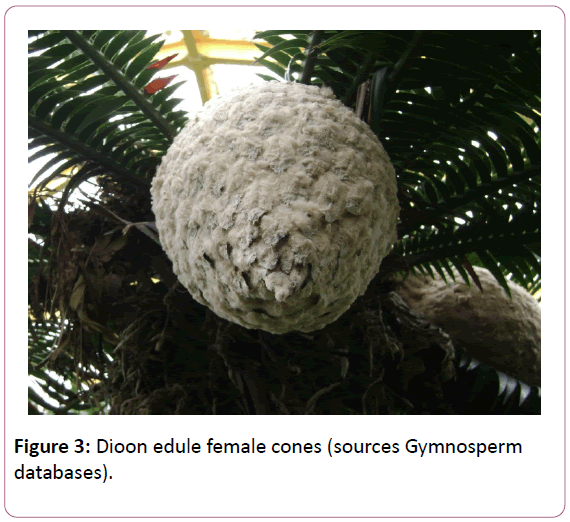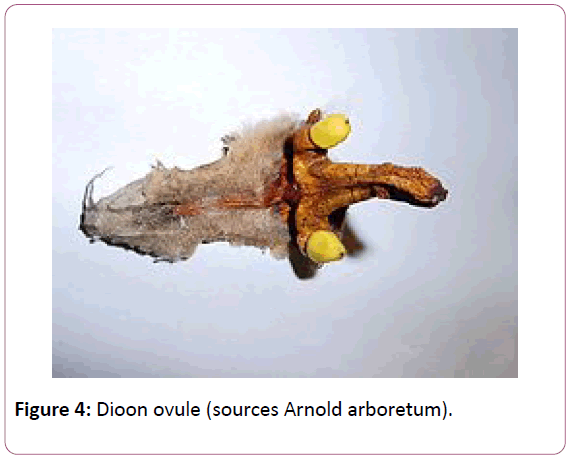Keywords
Extinct; Conservation; Medicinally; Economically; Belt; Native Place
Introduction
Cycadales are the living representative of the gymnosperms .They repressed the relict lines of the evolution. About 11 genera’s has been reported from all over the world [1]. There fossil history goes back into the Permian, however in the carboniferous time period, they flourish well [2,3]. In Jurassic period a long belt of the gymnosperm was reported in the fossil evidences from the India as well as the other parts of the world. They were at the tremendous diversity at that time [1]. There molecular phylogenetices shows that these plants are near to the extinction [4,5].
The distribution of the Dioon can be observed in all over the world, however in the Mexico there is long belt of the Dioon. Mexico mountain region is considered as the native places of the Dioon. Around 30 species of the Dioon has been reported from all over the world. However the plant body is divided in to the trunk, leaves and the very marvelous kind of the cones. In majority of the cases the Dioon trunk is underground [6]. Trunk around 20-400 cm long, 20-40 cm in diameter, entirely cylindrical, covered with persistent leaf bases, arborescent approximately 300 cm, generally decumbent at greater elevation. The length of the smallest cones male trunk has been observed 20 cm, smallest cones females 95 cm leaves numerous, 20-50 per crown, ascending to descending , 90-190 cm long , 14-25 cm wide, tomatoes green, rigid leaflet, sub opposite, apex acuminate [7].
Dioon species principally occur at the elevation of the 1200 -2000 m, on sleep limestone to the higher elevation of the Mexico (Figures 1 and 2).

Figure 1: Dioon species from the Mexico (sources Gymnosperm databases).

Figure 2: Dioon species, cones (sources Arnold arboretum).
Taxonomic revision of the Dioon tomasetti of the southern Mexico has been observed by Jeffery. They consider that there is enough evidence for the enlistment of the varieties in to the genera level [8].
Phytochemistry of the Dioon has been investigated by the number of the workers. In Dioon spinolosum, Cglycosylflavenoes, has been reported from the leaves by Carlos Wallace.
Biflavones of the Dioon has been investigated by the Dossell Wallace Bell.
Several bifflavones, bilobatein, seqioua, flavones, ginkgtene, sciadopityerenes [4,7] tetra methyl flavones, di flavones were identified and extract of the cycads Dioon biflavones has been identify by the NMR studies [8].
Phytochemical studies of the bioflavonoid contents of the Dioon edule land has been analyzed [9].
Phenolic contents and the antioxidant properties of the Dioon edule has been investigated by the recent methods of the separation (chromatographic and the HPLC method of the separation) (Figure 3).

Figure 3: Dioon edule female cones (sources Gymnosperm databases).
The total alcohol extract of the leaves followed by the spectroscopic method and the 1D, 2D NMR techniques [10].
Total phenolices, total flavenoids, and antioxidant activity of the leaves of the Dioon edule has been investigated [11].
Phylogenetic of the Dioon species has been investigated by the chloroplast, mitochondrial and the nuclear DNA isolation method. Molecular phylogenetic has been investigated by the individual and combined data sets of the ITS region of the ribosomal DNA and the other region of the chloroplast.
Epidermal micro morphology of the Dioon species has been investigated by the scanning and the transmission electron microscopy. It has been found that there is enough evidence on the basis of the epidermal features, to separate it in the different varieties or in the decades (Figure 4).

Figure 4: Dioon ovule (sources Arnold arboretum).
Economic Importance of the Dioon
• Leaves are commonly used as the ornamental purposes.
• Leaves are used for the religious purposes.
• In churches the leaves are used for the puja purposes.
• The sarcotesta are used as the sources of the food.
• The sarcotesta is used for the different ornamental purposes.
However, there many other use of the Dioon edule.
Conservation status
Dioon genera’s contains a number of the species, these are distributed in differ parts of the world; in this era the species are subjected to the many kinds of the threats, some of the species which are prone to the various kinds of the threats are enlisted as:
Dioon angustifoium: This species occur in the northern parts of the sierra Madre, oriental mountain range in Mexico (IUCN red data lists ). Mexico mountain range are the native places of the this species of the DIOON, this species is restricted to the certain mountain area of the Mexico, well the major consideration are that the area are under the major threats of the overexploitations of the over construction of the m nay human needs buildings, the natural habitats are degrading with the speed so IUCN red data lists included the species in the vulnerable categories (IUCN red data lists ).
Dioon argentum: This species is native to the some of the places of the mountaneous area of the Mexico, the place is known as the sierra nortae of Oaxaca Mexico. Oaxaca (Mexico) is then native place of this species. This species of the Dioon is also threaded to the many kinds of the threats; one of the major threats is the overexploitation of the habitat for the various kinds of the purposes so this species of the Dioon is also declared as the vulnerable and needs the conservation for the saving of the species (IUCN Red data lists).
Dioon califanoi: This species is also distributed only some of the provinces of the Mexico, the places are the Oaxaca and the pueberla of the Mexico, well the species has the major threats, due to which it has been reported that continue threats are the reasons for the declines of the populations of the Dioon due to the over exploitation during the 50 years, in 1998 the species has been termed as vulnerable but in 2003 it has been termed as the endangered species aedue to the over exploitation of the species for the various purposes by the tribal communities. Grazing and the over cuttings of the habitat are the reason for the degradation of the species in the places (IUCN red data lists).
Some of the other species of the Dioon are presenting over here which are also the subjects of the similar kinds of the threats and they are categorized as the vulnerable and near to the endangered for the continuous threats. Dioon cappotoi, Dioon edule, Dioon holmgenii, Dioon mejiae, Dioon merolae, Dioon persuii, Dioon sonorensae (IUCN red data lists).
Overall the genus is highly important from the evolutionary point of view and the ecological and economical values, gymnosperms are the rare gift of then nature and they needs the proper conservation for the magnificent evolution in the Mesozoic era, so the governments of the India as well as the other part of the world should do the serious concerns for the saving of the genera.
Conclusion
Dioon are the relict lines of the evolution of the gymnosperm. They are the only living fossils, they have the tremendous reservoirs of the metabolites of the medical and the ecological values, and however the tribes are utilizing the plant from the centuries. But Dioon like cycads are near the lines of the extinction. So we need to conserve these great liens of the evolution. They are the sources of the nucleic acids which are conserved long in the liens of the evolution (Mesozoic era). In India there are very few places which have the Dioon lines, otherwise in many places they are at the edges of the extinction. So internationally as well as in India these plants needs the conservation.
References
- IPNI (2010) Plant Name Details for Dioonpurpusii.
- Donaldson JS, Vovides A, Chemnick J (2003) Dioonpurpusii in IUCN 2010". IUCN Red List of Threatened Species. International Union for Conservation of Nature and Natural Resources.
- Carlos, I (2003) Morphological and geographical variations of the cycads Dioonedule , Botanicla journal of the linaean society 141: 465-470.
- Halbert SE (2010) Triology.
- Dallia M (2016) Gikgetin or isogingetin the dimethyl menthoflavones of Dioonedule. European journal of the medicnal plants 16:1-7.
- Dyer WTT (1883) Cycadaceae. European Journal of Medicinal Plants.
- Gonzalez-Astrorga J (2003) Revision of the Dion tomenserral (Zamiaceae) from western mexico, phytologia 83: 1-6.
- Moawad D, Amir E (2016) Total Phenolic, Total Flavonoid And Antioxidant Activity Of Some Plants Of Gemnosperms: Phytochemical Investigation Of DioonEduleLindl. Leaves Planta Med 82: 1-46.
- Standley PC (1920) Trees and Shrubs of Mexico. Smithsonian Institution, Washington D.C.: U.S. National Herbarium.
- Vovides PA(2003) A new species in the genus Dioon (Zamiaceae) form north central oaxacomexico.BotaniclaJournal of Linaen Society141: 471-476.
- Vovides A, Chemnick J, Gregory T(2010)Dioonspinulosum. The IUCN Red List of Threatened Species 2010: e.T42149A10667709.





